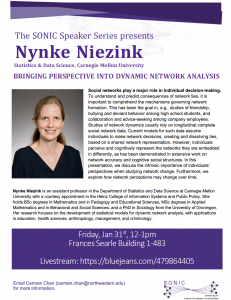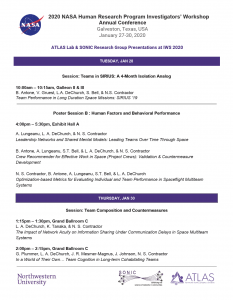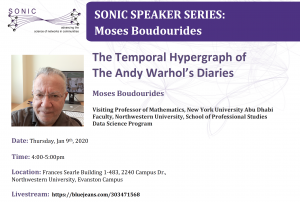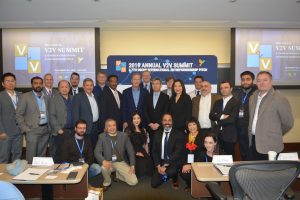
NASA work covered in Germany RBB Kulturradio radio broadcast
Our work for the MARS 2033 mission is covered in Germany RBB Kulturradio radio broadcast, episode “Auf der Suche nach dem idealen” (In search of the perfect team).
Listen to it here:
https://www.rbb-online.de/rbbkultur/radio/programm/schema/sendungen/kulturtermin/archiv/20200113_1904.html
Upcoming NASA HRP IWS 2020 presentations

SONIC Speaker Series Presents: Moses Boudourides
Video now available: https://www.youtube.com/watch?v=LtZhzoA8B0E
We are delighted to invite Professor Moses Boudourides to present “The Temporal Hypergraph of The Andy Warhol’s Diaries” today, 4pm, at FSB 1-483.

Abstract:
In Pat Hackett’s volume “The Andy Warhol Diaries,” we were able to identify automatically 2278 names of persons (celebrities, artists etc.), who happen to be mentioned in 2024 diaries during a period of 12 years, from November 24, 1976, to February 17, 1987. This was done using the standard Natural Languages Processing technique of POS tagging for the detection of 2-grams or 3-grams corresponding to persons’ names (first-last name, possibly including a middle name or a composite surname). Thus, each diary written in a particular day corresponds to a set of persons, who co-occur in the textual contents of the diary.
From the point of view of the theory of hypergraphs, the collection of diaries generates a (simple) undirected hypergraph G=(V,E), where each element of the set X, called vertex, is a person and each element of the set E, called hyperedge, is a set of (distinct) persons. In other words, each hyperedge is interpreted as a diary at a certain date involving a set of persons who happen to co-occur in that diary (persons counted as singletons even if they can be mentioned more than once in the same diary). Apparently, under this co-occurrence relation, The Andy Warhol’s Diaries give rise to a temporal (longitudinal) hypergraph, in which every hyperedge (diary) has a distinct time stamp (date).
Equivalently, from the network-analytic view, a single diary at a certain date corresponds to a clique of persons co-occurring in this diary. Moreover, by aggregating diaries written in a certain time period, one obtains a weighted undirected graph of persons, in which two persons are adjacent as far as there exists at least one date in this period, during which these persons co-occur in the corresponding diary (the number of such dates/diaries being the adjacency weight). Furthermore, in the usual way, one can define egocentric subgraphs during a certain period of dates. Notice that now k (larger than 2) egocentric subgraphs may define a multi-layer substructure in the hypergraph of diaries in that period of dates. Here, we are going to give an account of a number of different temporal-hypergraph-analytic computations on The Andy Warhol Diaries.
Bio:
Moses Boudourides Ph.D. is Visiting Professor of Mathematics at NYU Abu Dhabi (https://nyuad.nyu.edu/en/academics/divisions/science/faculty/moses-boudourides.html). He is also in the Faculty of Northwestern University School of Professional Studies Data Science Program (https://sps.northwestern.edu/masters/data-science/faculty.php) and Affiliated Faculty at the Science of Networks in Communities (SONIC) at Northwestern University (http://sonic.northwestern.edu/people/affiliated-faculty/moses-boudourides/).
His research work is on social network analysis, computational social science and digital humanities. In particular, his work in digital humanities is focused on networks of literary text and data analysis of scientometric datasets with emphasis on the temporal assortativity of various attributes in co-authorship and co-publication networks (as authors’ gender, publication keywords and journals’ Open Access type).
Early in 2019, he was awarded a Robert K. Merton Visiting Research Fellowship from the Institute for Analytical Sociology (IAS) at Linköping University in Sweden.
Noshir Contractor named ACM Fellow for advancements in computing
Congratulations, Noshir!
The Association for Computing Machinery (ACM) has named Noshir Contractor as one of its 2019 ACM Fellows.
ACM Fellows comprise an elite group that represents less than 1% of the association’s global membership. This year’s class was selected for far-reaching accomplishments that define the digital age and greatly impact our professional and personal lives.
Insight’s Building Great Team’s story is live
Our work is featured in Kellogg Insight’s “What Science Can Tell Us about Building Great Teams”:
https://insight.kellogg.northwestern.edu/building-leading-great-teams-research
Contractor gave keynote at annual V2V summit at Chicago
On November 23rd, Noshir Contractor was invited to give a keynote at annual V2V summit at downtown Chicago. Started in 2013, the summit is a broad “Entrepreneurship+” platform that connects US-based innovators and entrepreneurs with international investors, corporations, and strategic partners.
More about the summit: https://www.v2v-inno.com/agenda-speakers/#speakers
Citation:
Contractor, N. (November 23, 2019). Keynote address at the 2019 Annual V2V Summit, Chicago, IL.

Contractor gave keynote at Ahmedabad, India
Noshir was invited to give a keynote on “People Analytics: Using Digital Exhaust to Leverage Network Insights in the Workplace” at the International conference on “Network Science in Economics and Finance.”
More about the conference: https://conference.iima.ac.in/nsef19/program/
Citation:
Contractor, N. (December 9, 2019). People Analytics: Using Digital Exhaust to Leverage Network Insights in the Workplace. Keynote address at the International conference on “Network Science in Economics and Finance”, Ahmedabad, India.
Diego and Kyosuke presenting at Weds@NICO Seminar Series
Our graduate students, Diego and Kyosuke, are going to present their research this Weds, Dec 4th, 12:00-1:00pm, at Wednesdays@NICO Seminar Series: Lightning Talks with Northwestern Fellows and Scholars. Below please find their titles and abstracts.
More event details: https://www.nico.northwestern.edu/news-events/events/?eid=554819
Presenter: Kyosuke Tanaka
Title: How dispositional and positional factors affect an individual’s ability to efficiently route messages in a network
Abstract: Milgram’s small-world experiment provided evidence for six degrees of separation, on average a chain of five contacts separated any two random people in the world. However, this was only true for those messages that reached the final destination. While, in theory, the small-world phenomenon is structurally common in social networks, empirical evidence shows that human navigation of small-world social networks is remarkably challenging. Messages often reach the intended destination via a longer path than expected, get enmeshed in loops, and/or often never reach it. This leads to painful consequences for organizations that require information routing to share (or retrieve) knowledge among their members. Extreme examples of these failures contributed to the loss of the space shuttles Challenger and Columbia. Here, I present a study of an understudied type of error—network routing—and introduce network acuity to conceptualize and operationalize an individual’s ability to efficiently route messages. Using, 6-DoS (Six Degrees of Separation), a network routing task based on Milgram’s small-world experiment with 435 individuals organized into 25 networks, I explored two types of factors that impact an individual’s network acuity: positional factors (where you are in the network) and dispositional factors (who you are). Results show that (a) those in the core or brokerage position had high network acuity than did peripheral or non-bridge members, (b) neuroticism was positively associated with acuity, (c) conscientiousness was negatively associated with acuity. Further, individuals’ network positions impacted network acuity more than dispositional characteristics. The results of this experimental study illustrate not only the usefulness of the concept of network acuity to characterize network routing errors but also advance our understanding of factors that explain variance in individuals’ network acuity.
Noshir Contractor elected as 2019 AAAS Fellow
We are delighted to share that Noshir Contractor has been elected as 2019 fellow of the American Association for the Advancement of Science (AAAS). He is recognized for intellectual leadership in the development of computational social science and web science and his contributions to network science theory and methodology. He will be honored on Feb 15 at the 2020 AAAS Annual Meeting in Seattle, Washington.
Read more:
https://news.northwestern.edu/stories/2019/11/five-professors-named-aaas-fellows/
